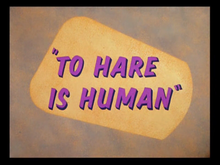| To Hare is Human | |
|---|---|
 | |
| Directed by | Chuck Jones |
| Story by | Michael Maltese |
| Produced by | Edward Selzer |
| Starring | Mel Blanc |
| Music by | Milt Franklyn |
| Animation by | Abe Levitow Richard Thompson Ken Harris Ben Washam |
| Layouts by | Maurice Noble |
| Backgrounds by | Philip DeGuard |
| Color process | Technicolor |
| Distributed by | Warner Bros. Pictures The Vitaphone Corporation |
| Release date |
|
| Running time | 6:59 |
| Language | English |
To Hare is Human is a 1956 Warner Bros. Merrie Melodies cartoon directed by Chuck Jones. The short was released on December 15, 1956, and stars Bugs Bunny and Wile E. Coyote. In this film, Wile builds a UNIVAC computer, and grows to rely on its answers.
Plot
Wile E. Coyote employs a series of increasingly elaborate schemes to capture Bugs Bunny, utilizing a foldable elevator and a super smart computer called UNIVAC. In one scenario, Wile E. Coyote ensnares Bugs Bunny in a sack rigged with dynamite but is outsmarted when Bugs escapes, causing an explosion that buys him time to flee. Undeterred, Wile E. Coyote utilizes the UNIVAC to devise new strategies, each met with humorous failure.
First, Wile E. attempts to unlock Bugs' rabbit hole using the UNIVAC's guidance, only to slip on a banana peel and plummet off a cliff. In another attempt, he substitutes hand grenades for Bugs' breakfast carrots, but the plan backfires when the grenades are launched back at him. A subsequent effort involving a bathroom plunger leads to Wile E. being sucked into his own trap.
In a fourth endeavor, Wile E. inserts dynamite into Bugs' vacuum cleaner, resulting in a comedic explosion when Bugs inadvertently reignites the fuse. Finally, Wile E. sets a booby trap in the carrot patch, but it backfires, leading to his own demise. The revelation that Bugs Bunny is the true mastermind behind the UNIVAC's calculations adds a humorous twist to the failed attempts, highlighting Bugs' cleverness and Wile E. Coyote's perpetual misfortune.
Production notes
The title is a play on the expression, "To err is human; to forgive, divine." This was also the final cartoon to be made at Termite Terrace before the studio moved to the Burbank lot.
Home media
The short was released on the Looney Tunes Golden Collection: Volume 4, Disc One.
References
- Beck, Jerry; Friedwald, Will (1989). Looney Tunes and Merrie Melodies: A Complete Illustrated Guide to the Warner Bros. Cartoons. Henry Holt and Co. p. 293. ISBN 0-8050-0894-2.
- Lenburg, Jeff (1999). The Encyclopedia of Animated Cartoons. Checkmark Books. pp. 60–62. ISBN 0-8160-3831-7. Retrieved 6 June 2020.
External links
| Preceded byWideo Wabbit | Bugs Bunny Cartoons 1956 |
Succeeded byAli Baba Bunny |
| Wile E. Coyote and the Road Runner in animation | |||||||||||||||||
|---|---|---|---|---|---|---|---|---|---|---|---|---|---|---|---|---|---|
| Short films |
| ||||||||||||||||
| Feature films |
| ||||||||||||||||
| TV series |
| ||||||||||||||||
| TV specials |
| ||||||||||||||||
| Chuck Jones | |||||||||||||
|---|---|---|---|---|---|---|---|---|---|---|---|---|---|
| Short subjects |
| ||||||||||||
| Television specials |
| ||||||||||||
| Feature films |
| ||||||||||||
| Television series |
| ||||||||||||
| Books |
| ||||||||||||
| Characters |
| ||||||||||||
| Other works | |||||||||||||
- 1956 films
- Merrie Melodies short films
- Warner Bros. Cartoons animated short films
- Wile E. Coyote and the Road Runner films
- Short films directed by Chuck Jones
- Films scored by Milt Franklyn
- Bugs Bunny films
- 1950s Warner Bros. animated short films
- Films with screenplays by Michael Maltese
- Films about computing
- UNIVAC
- Films produced by Edward Selzer
- 1950s English-language films
- English-language short films
- 1956 animated short films